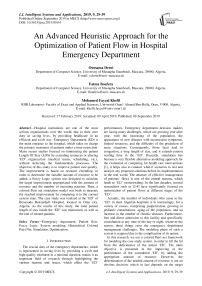An advanced heuristic approach for the optimization of patient flow in hospital emergency department
Автор: Oussama Derni, Fatma Boufera, Mohamed Faycal Khelfi
Журнал: International Journal of Intelligent Systems and Applications @ijisa
Статья в выпуске: 9 vol.11, 2019 года.
Бесплатный доступ
Hospital institutions are one of the most serious organizations over the world, due to their core duty in saving lives, by providing healthcare in an efficient and swift way. Emergency Department (ED) is the main entrance to the hospital, which takes on charge the primary treatment of patients under a time restriction. Many recent studies focused on minimizing the patient Length Of Stay (LOS) by extending resources or altering ‘ED’ organization (medical teams, scheduling, etc.), without defecting the fundamentals processes. The objective of this study is to improve patient care quality. The improvement is based on resource extending, in order to determine the suitable amount of resource to be added, a Fuzzy Logic system was designed to calculate the target improvement appropriated with the amount of resource and the number of incoming patients. Then, a colored Petri net simulation model was built to measure the reached improvement by comparing it to the current system state. The case study was realized at the ‘ED’ of Benaouda Benzerdjeb Hospital, located in Oran city, Algeria. As the results of this study, the total patient length of stay inside the ‘ED’ was minimized, as well as the rate of treated patients.
Emergency department, Patient flow, Fuzzy Logic, System modeling, Hierarchical Colored Petri Net, Simulation, Optimization
Короткий адрес: https://sciup.org/15016621
IDR: 15016621 | DOI: 10.5815/ijisa.2019.09.04
Список литературы An advanced heuristic approach for the optimization of patient flow in hospital emergency department
- He, Y., Cai, B., and Wang, M. Research on Optimization of Registration Procedure in Emergency Department Based on System Simulation, Procedia Computer Science, 91:37–46, 2016.
- Sánchez, M., Suárez, M., Asenjo, M. and Bragulat, E. Improvement of emergency department patient flow using lean thinking, International Journal for Quality in Health Care, 30(4):250–256, 2018.
- Garrett, J. S., Berry, C., Wong, H., Qin, H. and Kline, J. A. The effect of vertical split-flow patient management on emergency department throughput and efficiency, American Journal of Emergency Medicine, 36(9):1581–1584, 2018.
- Kelley, D. P. and Gravina, N. Every Minute Counts: Using Process Improvement and Performance Feedback to Improve Patient Flow in an Emergency Department, Journal of Organizational Behavior Management, 38(2-3:234–243, 2018.
- Kuo, Y. H., Leung, J. M. Y., Tsoi, K. K. F., Meng, H. M. and Graham, C. A. Embracing Big Data for Simulation Modelling of Emergency Department Processes and Activities, IEEE International Congress on Big Data, New York, 2015, (New York, NY, USA), pp. 313–316.
- Marsden, E., Taylor, A., Wallis, M., Craswell, A., Broadbent, M., Barnett, A., Nguyen, K. H., Crilly, J., Johnston, C. and Glenwright, A. A structure, process and outcome evaluation of the Geriatric Emergency Department Intervention model of care: a study protocol, BMC Geriatrics, 17(76):1–8, 2017.
- Chang, A.M., Cohen, D. J., Lin, A., Augustine, J., Handel, D. A., Howell, E., Kim, H., Pines, J. M., Schuur, J. D., McConnell, K. J. and Sun, B. C. Hospital Strategies for Reducing Emergency Department Crowding: A Mixed-Methods Study, Annals of Emergency Medicine, 71(4):497–505, 2017.
- Burstein, B., Fauteux-Lamarre, E., Cheng, A., Chalut, D. and Bretholz, A. Simulation and Web-based learning increases utilization of Bier block for forearm fracture reduction in the pediatric emergency department, Canadian Journal of Emergency Medicine, 19(6):434–440, 2016.
- Gul, M. and Guneri, A. F. A comprehensive review of emergency department simulation applications for normal and disaster conditions, Computers & Industrial Engineering, 83:327–344, 2015.
- Reeder, T. J., Burleson, D. L. and Garrison, H. G. The Overcrowded Emergency Department: A Comparison of Staff Perceptions, official journal of the Society for Academic Emergency Medicine, 10(10):1059–1064, 2003.
- Rahmani, F., Rezazadeh, F., Ala, A., Soleimanpour, M., Esfanjani, R. M. and Soleimanpour, H. Evaluation of Overcrowding of Emergency Department in Imam Reza Hospital in 2015 by Implementing 2 Scales: NEDOCS and EDWIN, Iran Red Crescent Med, 19(6)1–4, 2017.
- Ahalt, V., Argon, N. T., Ziya, S., Strickler, J. and Mehrotra, A., Comparison of emergency department crowding scores: a discrete-event simulation approach, Health care management science, 21(1):144–155, 2016.
- Chartier, L. B., Simoes, L., Kuipers, M. and McGovern, B. Improving Emergency Department flow through optimized bed utilization, BMJ quality improvement reports, 5(1):1-6, 2016.
- Puente, J., Gómez, A., Parreño, J. and Fuente, D. Applying a fuzzy logic methodology to waiting list management at a hospital emergency unit: a case study, International Journal of Healthcare Technology and Management, 5(6):432–442, 2003.
- Azadeh, A., Rouhollah, F., Davoudpour, F. and Mohammadfam, I. Fuzzy modelling and simulation of an emergency department for improvement of nursing schedules with noisy and uncertain inputs, International Journal of Services and Operations Management, 15(1): 58–77, 2013.
- Mamdani, E. H. Application of Fuzzy Logic to Approximate Reasoning Using Linguistic Synthesis. IEEE Transactions on Computers, 26(12):1182–1191, 1977.
- Mamdani, E. H. and Assilian, S. An Experiment in Linguistic Synthesis with a Fuzzy Logic Controller, International Journal of Man-Machine Studies, 7(1):1–13, 1975.
- Jensen, K. Coloured Petri Nets Theory, Basic Concepts, Analysis Methods and Practical Use Volume 1 (Berlin Heidelberg, New York in 1992).
- Ratzer, A. V., Wells, L., Lassen, H. M., Laursen, M., Qvortrup, J. F., Stissing, M. S., Westergaard, M., Christensen, S. and Jensen, K. CPN Tools for Editing, Simulating, and Analysing Coloured Petri Nets’ in Eindhoven (2003): International Conference on Applications and Theory of Petri Nets and Concurrency, 2003, (Eindhoven, The Netherlands), pp.450–462.
- Westergaard, M. and Kristensen, L. M., ‘The Access/CPN Framework: A Tool for Interacting with the CPN Tools Simulator’ in Paris (2009): International Conference on Applications and Theory of Petri Nets, 2009, (Paris, France), pp.313–322.


